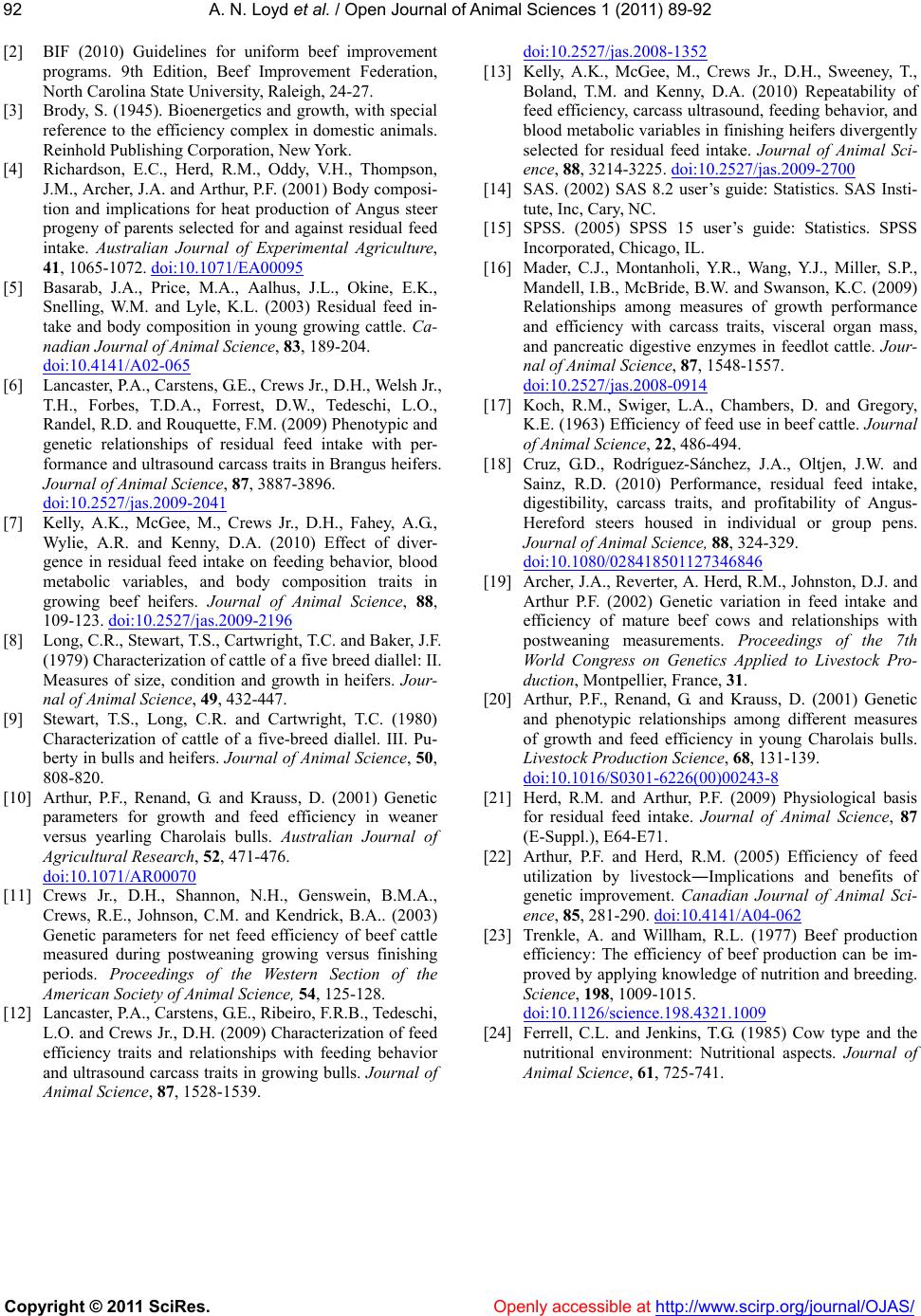
A. N. Loyd et al. / Open Journal of Animal Scienc es 1 (2011) 89-92
Copyright © 2011 SciRes. Openly accessible at http://www.scirp.org/journal/OJAS/
92
[2] BIF (2010) Guidelines for uniform beef improvement
programs. 9th Edition, Beef Improvement Federation,
North Carolina State University, Raleigh, 24-27.
[3] Brody, S. (1945). Bioenergetics and growth, with special
reference to the efficiency complex in domestic animals.
Reinhold Publishing Corporation, New York.
[4] Richardson, E.C., Herd, R.M., Oddy, V.H., Thompson,
J.M., Archer, J.A. and Arthur, P.F. (2001) Body composi-
tion and implications for heat production of Angus steer
progeny of parents selected for and against residual feed
intake. Australian Journal of Experimental Agriculture,
41, 1065-1072. doi:10.1071/EA00095
[5] Basarab, J.A., Price, M.A., Aalhus, J.L., Okine, E.K.,
Snelling, W.M. and Lyle, K.L. (2003) Residual feed in-
take and body composition in young growing cattle. Ca-
nadian Journal of Animal Science, 83, 189-204.
doi:10.4141/A02-065
[6] Lancaster, P.A., Carstens, G.E., Crews Jr., D.H., Welsh Jr.,
T.H., Forbes, T.D.A., Forrest, D.W., Tedeschi, L.O.,
Randel, R.D. and Rouquette, F.M. (2009) Phenotypic and
genetic relationships of residual feed intake with per-
formance and ultrasound carcass traits in Brangus heifers.
Journal of Animal Science, 87, 3887-3896.
doi:10.2527/jas.2009-2041
[7] Kelly, A.K., McGee, M., Crews Jr., D.H., Fahey, A.G.,
Wylie, A.R. and Kenny, D.A. (2010) Effect of diver-
gence in residual feed intake on feeding behavior, blood
metabolic variables, and body composition traits in
growing beef heifers. Journal of Animal Science, 88,
109-123. doi:10.2527/jas.2009-2196
[8] Long, C.R., Stewart, T.S., Cartwright, T.C. and Baker, J.F.
(1979) Characterization of cattle of a five breed diallel: II.
Measures of size, condition and growth in heifers. Jour-
nal of Animal Science, 49, 432-447.
[9] Stewart, T.S., Long, C.R. and Cartwright, T.C. (1980)
Characterization of cattle of a five-breed diallel. III. Pu-
berty in bulls and heifers. Journal of Animal Science, 50,
808-820.
[10] Arthur, P.F., Renand, G. and Krauss, D. (2001) Genetic
parameters for growth and feed efficiency in weaner
versus yearling Charolais bulls. Australian Journal of
Agricultural Research, 52, 471-476.
doi:10.1071/AR00070
[11] Crews Jr., D.H., Shannon, N.H., Genswein, B.M.A.,
Crews, R.E., Johnson, C.M. and Kendrick, B.A.. (2003)
Genetic parameters for net feed efficiency of beef cattle
measured during postweaning growing versus finishing
periods. Proceedings of the Western Section of the
American Society of Animal Science, 54, 125-128.
[12] Lancaster, P.A., Carstens, G.E., Ribeiro, F.R.B., Tedeschi,
L.O. and Crews Jr., D.H. (2009) Characterization of feed
efficiency traits and relationships with feeding behavior
and ultrasound carcass traits in growing bulls. Journal of
Animal Science, 87, 1528-1539.
doi:10.2527/jas.2008-1352
[13] Kelly, A.K., McGee, M., Crews Jr., D.H., Sweeney, T.,
Boland, T.M. and Kenny, D.A. (2010) Repeatability of
feed efficiency, carcass ultrasound, feeding behavior, and
blood metabolic variables in finishing heifers divergently
selected for residual feed intake. Journal of Animal Sci-
ence, 88, 3214-3225. doi:10.2527/jas.2009-2700
[14] SAS. (2002) SAS 8.2 user’s guide: Statistics. SAS Insti-
tute, Inc, Cary, NC.
[15] SPSS. (2005) SPSS 15 user’s guide: Statistics. SPSS
Incorporated, Chicago, IL.
[16] Mader, C.J., Montanholi, Y.R., Wang, Y.J., Miller, S.P.,
Mandell, I.B., McBride, B.W. and Swanson, K.C. (2009)
Relationships among measures of growth performance
and efficiency with carcass traits, visceral organ mass,
and pancreatic digestive enzymes in feedlot cattle. Jour-
nal of Animal Science, 87, 1548-1557.
doi:10.2527/jas.2008-0914
[17] Koch, R.M., Swiger, L.A., Chambers, D. and Gregory,
K.E. (1963) Efficiency of feed use in beef cattle. Journal
of Animal Science, 22, 486-494.
[18] Cruz, G.D., Rodríguez-Sánchez, J.A., Oltjen, J.W. and
Sainz, R.D. (2010) Performance, residual feed intake,
digestibility, carcass traits, and profitability of Angus-
Hereford steers housed in individual or group pens.
Journal of Animal Science, 88, 324-329.
doi:10.1080/028418501127346846
[19] Archer, J.A., Reverter, A. Herd, R.M., Johnston, D.J. and
Arthur P.F. (2002) Genetic variation in feed intake and
efficiency of mature beef cows and relationships with
postweaning measurements. Proceedings of the 7th
World Congress on Genetics Applied to Livestock Pro-
duction, Montpellier, France, 31.
[20] Arthur, P.F., Renand, G. and Krauss, D. (2001) Genetic
and phenotypic relationships among different measures
of growth and feed efficiency in young Charolais bulls.
Livestock Production Science, 68, 131-139.
doi:10.1016/S0301-6226(00)00243-8
[21] Herd, R.M. and Arthur, P.F. (2009) Physiological basis
for residual feed intake. Journal of Animal Science, 87
(E-Suppl.), E64-E71.
[22] Arthur, P.F. and Herd, R.M. (2005) Efficiency of feed
utilization by livestock―Implications and benefits of
genetic improvement. Canadian Journal of Animal Sci-
ence, 85, 281-290. doi:10.4141/A04-062
[23] Trenkle, A. and Willham, R.L. (1977) Beef production
efficiency: The efficiency of beef production can be im-
proved by applying knowledge of nutrition and breeding.
Science, 198, 1009-1015.
doi:10.1126/science.198.4321.1009
[24] Ferrell, C.L. and Jenkins, T.G. (1985) Cow type and the
nutritional environment: Nutritional aspects. Journal of
Animal Science, 61, 725-741.